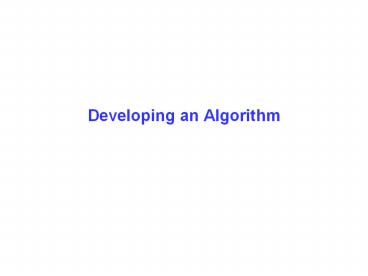Developing an Algorithm - PowerPoint PPT Presentation
1 / 13
Title:
Developing an Algorithm
Description:
Processing: a list of actions needed to produce the required outputs. ... First, underline the nouns and adjectives used in the specification ... – PowerPoint PPT presentation
Number of Views:56
Avg rating:3.0/5.0
Title: Developing an Algorithm
1
Developing an Algorithm
2
Objectives
- In this chapter you will be able to
- Introduce methods of analyzing a problem and
developing a solution - Develop simple algorithms using the sequence
control structure - Introduce methods of manually checking the
developed solution
3
Defining the Problem
- To help with this initial analysis, the problem
should be divided into three separate components - Input a list of the source data provided to the
problem. - Output a list of the outputs required.
- Processing a list of actions needed to produce
the required outputs. - When dividing a problem into its three different
components, you should simply analyze the actual
words used in the specification, and divide them
into those that are descriptive and those that
imply actions
4
Example 3.1 Add Three Numbers
- A program is required to read three numbers, add
them together and print their total - Tackle this problem in two stages
- First, underline the nouns and adjectives used in
the specification - This will establish the input and output
components, as well as any objects that are
required - Second, underline (in a different color) the
verbs and adverbs used in the specification
5
Example 3.1 Add Three Numbers
- By looking at the underlined words, you can see
that the processing verbs are read, add
together, and print - These steps can now be added to our defining
diagram to make it complete - When it comes to writing down the processing
steps in an algorithm, you should use words that
describe the work to be done in terms of single,
specific tasks or functions - There is a pattern in the words chosen to
describe these steps - Each action is described as a single verb
followed by a two-word object
6
Example 3.2 Find Average Temperature
- First establish the input and output components
by underlining the nouns and adjectives in the
problem statement - Now establish the processing steps by underlining
the verbs in the problem statement - The processing verbs are prompt, accept,
calculate, and display - By finding the associated objects of these verbs,
the defining diagram can now be completed
7
Example 3.3 Compute Mowing Time
- To establish the input and output components in
this problem, the nouns of objects have been
underlined - By reading these words, you can see that the
input components are the length and width of the
block, and the length and width of the house
8
Designing a Solution Algorithm
- Designing a solution algorithm is the most
challenging task in the life cycle of a program - Once the problem has been properly defined, you
usually begin with a rough sketch of the steps
required to solve the problem - The first attempt at designing a particular
algorithm usually does not result in a finished
product - Pseudocode is useful in this trial-and-error
process, since it is relatively easy to add,
delete, or alter an instruction
9
Checking the Solution Algorithm
- After a solution algorithm has been established,
it must be tested for correctness - This step is necessary because most major logic
errors occur during the development of the
algorithm, and if not detected, these errors can
be passed on to the program - Desk checking involves tracing through the logic
of the algorithm with some chosen test data
10
Selecting Test Data
- When selecting test data to desk check an
algorithm, you must look at the program
specification and choose simple test cases only,
based on the requirements of the specification,
not the algorithm - By doing this, you will still be able to
concentrate on what the program is supposed to
do, not how
11
Steps in Desk Checking an Algorithm
- There are six simple steps to follow when desk
checking an algorithm listed on page 26 of the
textbook - By desk checking an algorithm, you are attempting
to detect early errors - It is a good idea for someone other than the
author of the solution algorithm to design the
test data for the program, as they are not
influenced by the program logic
12
Summary
- The first section of this chapter was devoted to
methods of analyzing and defining a programming
problem - You must fully understand a problem before you
can attempt to find a solution - The method suggested was to analyze the actual
words used in the specification with the aim of
dividing the problem into three separate
components input, output, and processing
13
Summary
- The second section was devoted to the
establishment of a solution algorithm - After the initial analysis of the problem, you
must attempt to find a solution and express the
solution as an algorithm - The third section was concerned with checking the
algorithm for correctness































